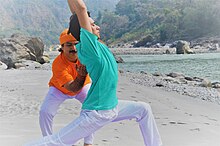Yoga Teacher
Standards

In America, the Yoga Alliance sets the 200-hour and 500-hour Recognized Yoga Teacher levels (RYT-200 and RYT-500). Training courses (200 hours initially for the RYT-200, then 300 hours to reach RYT-500) to qualify at these levels are provided by many independent yoga schools, teaching varied styles of yoga, both in America and other countries, including Britain. Yoga International notes that established yoga studios often require their teachers to pass the studios' own training courses.
The British Wheel of Yoga (BWY) in the United Kingdom offers Level 4 qualifications (Certificate in Yoga Teaching, Diploma in Teaching Yoga), stated to be equivalent to an HNC or the first year of a university degree. Training is provided by BWY itself; accreditation is by a separate organisation, BWYQ which split from BWY in 2009. The BWY is recognised by Sport England as the governing body of yoga in Britain (and in Northern Ireland, the Yoga Fellowship of Northern Ireland), though without power to enforce decisions. Qualifications are in turn regulated by the regulator of qualification standards Ofqual. By 2015, nine schools were accredited to teach to BWY standards; other schools were free to offer their own courses, often shorter and cheaper than the BWY's, as long as they did not claim to be to approved by the BWY.
Across Europe, standards are set by the European Union of Yoga (EUY), which has some 24 member associations in at least 15 countries including Austria, Belgium, Britain, Finland, France, Germany, Ireland, Israel, Italy, Netherlands, Portugal, Romania, Slovakia, Spain, and Switzerland. The EUY standards require a minimum of 500 hours of class instruction over a period of four years, assessed by an oral examination, a written examination, and a practical teaching demonstration. Member organisations such as Germany's Yoga Teachers' Union, the BDY, organise their own training in compliance with EUY standards.
Syllabuses
| Hatha yoga | Other activities | Yoga context | Practical skills |
|---|---|---|---|
Meditation |
Yoga history |
Teaching methods |
The syllabuses taught to trainee teachers vary with the school but include the components of hatha yoga, namely asanas, pranayama, and bandhas, and sometimes details of the subtle body with chakras, nadis and koshas; meditation; anatomy and physiology; psychology and philosophy of yoga; teaching methods; and the practicalities of running a yoga business. Some attention may be given to specific techniques such as Restorative Yoga and yoga nidra. Syllabuses are more tightly constrained if they are for registration with the Yoga Alliance or the British Wheel of Yoga.
Courses
Yoga teacher training, as of 2017, could cost between $2,000 and $5,000. It can take up to 3 years to obtain a teaching certificate. Shorter courses are offered in India, especially in the yoga hubs of Rishikesh and Mysore, and many Westerners travel to India hoping to learn "authentic" yoga in ashrams there.
See also
References
- ^ Scott, Rachel. "How to Choose a Teacher Training". Yoga International. Retrieved 8 May 2019.
- ^ "Yoga Alliance 200-Hour Teacher Training". Yoga London. Retrieved 8 May 2019.
- ^ Witts, Mat (2014). "Reportage: The British Wheel of Yoga". yuj.it. Retrieved 6 February 2017.
- ^ "Sporting Activities and Governing Bodies Recognised by the Sports Councils" (PDF). Sport England. April 2016. Archived from the original (PDF) on 12 July 2019. Retrieved 12 July 2019.
- ^ "Become a yoga teacher". British Wheel of Yoga. Retrieved 8 May 2019.
- ^ Lisinski, Anna (22 June 2015). "The truth behind becoming a yoga teacher". The Telegraph. Retrieved 8 May 2019.
- ^ "40 Years European Union of Yoga" (PDF). European Union of Yoga. 2013. Retrieved 25 March 2022.
- ^ Mullins, Daya. "Yoga and Yoga Therapy in Germany Today" (PDF). Weg Der Mitte. Retrieved 4 September 2019.
- ^ "One Yoga London 200 Hour Yoga Teacher Training: Syllabus for Registration with Yoga Alliance UK" (PDF). Archived from the original (PDF) on 8 May 2019. Retrieved 8 May 2019.
- ^ Delaney, Brigid (17 September 2017). "The yoga industry is booming – but does it make you a better person?". The Guardian.
- ^ Maddox, Callie Batts (2014). "Studying at the source: Ashtanga yoga tourism and the search for authenticity in Mysore, India". Journal of Tourism and Cultural Change. 13 (4): 330–343. doi:10.1080/14766825.2014.972410. ISSN 1476-6825. S2CID 143449133.
- ^ Ward, Mariellen (15 March 2012). "How to 'do' a yoga ashram in India".
